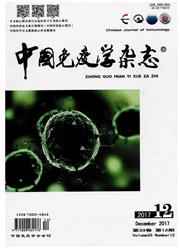

 中文摘要:
中文摘要:
目的:特异性抑制TGF-β,观察Smad2/3、ILK信号蛋白变化,评估TGF-β1/Smad/ILK信号通路在环孢素肾病(CCN)模型小鼠小管间质纤维化中的作用。方法:BALB/c小鼠随机分成:环孢素模型组(CMG)、干预模型组(IMG)、溶媒对照组(SCG)、低盐对照组(LCG)和正常对照组(NCG)。CMG与IMG组采用低盐饲养并环孢素60 mg/(kg·d)灌胃,从第28天腹腔给予TGF-β1特异抑制剂SB-431542 10 mg/(kg·2 d),第38天后采样,比较各组血清肌酐(Scr);观察肾组织羟脯氨酸(Hyp)含量及其病理变化,免疫组化或Western blot观察TGF-β1、P-Smad2/3、ILK表达,RT-PCR检测TGF-β1、Smad2/3及ILK mRNA表达。结果:CMG和IMG小鼠SCr显著升高(P〈0.01),肾小管结构不同程度损伤,间质炎性细胞增多,蓝色胶原染色不同程度增多,肾组织Hyp含量明显增多(P〈0.01),其中IMG上述指标较CMG明显改善。CMG和IMG小鼠肾小管间质TGF-β1、P-Smad2/3及ILK基因和蛋白表达明显增强(P〈0.01),而IMG上述因子表达明显低于CMG(P〈0.05)。肾脏Hyp含量与Scr、TGF-β1、P-Smad 2/3、ILK水平呈正相关(r=0.860、0.711、0.776、0.676,均P〈0.01)。结论:TGF-β1/Smads信号通路是CCN模型小鼠肾间质纤维化重要机制之一;ILK参与CCN小管间质纤维化,且可能系TGF-β1/Smads信号通路下游因子参与CCN小管间质纤维化进程。
 英文摘要:
英文摘要:
Objective :To investigate the effect of specific inhibition of transforming growth factor-[31 (TGF-IM) with SB-431542 on the Smad2/3 and integrin-linked kinase (ILK) signaling molecules in tubule interstitial fibrosis(TIF)-induced cyclosporine A(CsA) in mouse. Methods :50 BALB/c mice were randomly divided into 5 groups (10 mice per group) :the CsA model group (CMG) ,the inter- ventional model group (IMG), the solvent control group (SCG), the low-salt control group (LCG), and the normal control group (NCG). The model mouse was established with low-sodium diet and intragastric administration of cyclosporine A, which was dissolved in olive oil at a dose of 60 mg/(kg · d). After 4 weeks, a specific inhibitor of TGF-131 (SB-431542)was administered intraperitoneally with 10 mg/(kg · 2 d) for 10 days (every other days). Mice were sacrificed at day 38. Serum ereatinine (Ser) was measured,hydroxyp roline (Hyp) level and morphological changes of renal tissue were analyzed, expression levels of TGF-J31, P-Smad 2/3 and ILK were respectively detected by immunohistochemistry or Western blot, mRNA levels of TGF-I, Smad 2/3 and ILK were respectively detected real-time polymerase chain reaction (RT-PCR). Results:Compared with three control groups (NCG, LCG and SCG), mice weight was decreased significantly, Set level was increased significantly in two modeling groups (CMG and IMG) (P〈0. 01 ), and these changes in CMG were more obvious than those of IMG ( P〈0.05 ). Different levels of tubulointerstitial injury,interstitial infiltration of inflammatory cells and blue collagen staining in two modeling groups were observed, and particularly evident in CMG. TGF-131, P-Smad2/3 and ILK immunostaining were mainly expressed in tubulointerstitium. The TGF-131 ,P-Smad2/3 and ILK mRNA and immunostaining levels in two modeling groups were significantly increased as compared with three control groups (P 〈 0. 01 ), but their levels in IMG were
 同期刊论文项目
同期刊论文项目
 同项目期刊论文
同项目期刊论文
 期刊信息
期刊信息
